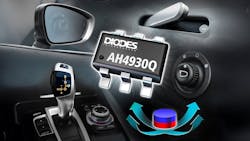3D Linear Hall-Effect Sensor Simplifies Rotary Motion and Proximity Detection
What you’ll learn:
- Insight on Diodes Inc.’s first automotive-compliant 3D linear Hall-effect sensor.
- How it allows for reliable and high-precision contactless rotary motion and proximity detection.
- Application targets for the sensor.
Named after physicist Edwin Hall, Hall-effect sensors leverage the Hall-effect principle to detect and measure magnetic fields, making them essential ingredients in various automotive systems. The sensors reveal how a voltage difference, or Hall voltage, is generated perpendicular to both an electric current and a magnetic field when a conductive material experiences the influence of that magnetic field.
Hall-effect sensors are critical for functions such as engine management, transmission control, and braking systems. Other applications include rotary and push selectors on infotainment systems, stalk gear shifters, door handles and locks, and powered seat adjusters.
An Automotive 3D Linear Hall-Effect Sensor
Entering the fray, Diodes Inc. recently introduced its first automotive-compliant 3D linear Hall-effect sensor. The AH4930Q detects the magnetic field in the X, Y, and Z directions, allowing for reliable and high-precision contactless rotary motion and proximity detection.
The part features on-chip integrated temperature sensor data available for system functions such as junction temperature indication and temperature compensation of magnetic-field measurement. A precision analog signal-path along with integrated ADC digitizes the measured analog magnetic field values, allowing the AH4930Q to decode the absolute position of any moving magnet.
The AH4930Q signal path and 12-bit data converter via an ADC provide high resolution for each measurement direction down to 1 Gauss (0.1 mT) per bit for positional accuracy. The implemented I2C interface enables communication for measurement data reading and runtime programming with host systems as fast as 1 Mb/s to support real-time adjustments.
Three Power Modes Plus Power-Down
The device has three operating modes plus a power-down mode where it consumes only 9 nA. Its three operating modes provide a power-consumption/data-acquisition compromise. This includes a low-power mode consuming only 13 µA (10 Hz) and a fast-sampling mode of 3.8 mA (3.3 kHz) for constant measurement functionality. With a 10-µs wake-up time, 4-µs response time, and wide bandwidth, the AH4930Q delivers fast data acquisition for the most demanding applications.
The sensor is runtime programmable and offers on-chip temperature compensation of the measured units. The selectable power-mode control unit enables low-power and continuous measurement functionality. Applications include any that require accurate angular measurements or low power consumption.
The AH4930Q operates on supply voltages from 2.8 to 5.5 V, and a temperature range from −40 to +125°C. The sensor comes in the industry-standard 6-pin SOT26 (Type A1) package and is available at $0.50 for 1,000-piece quantities. The part is automotive-compliant—qualified to AEC-Q100 Grade 1, and manufactured in facilities certified to IATF 16949, supporting Production Part Approval Process (PPAP) documents.
PPAP is a standardized procedure, primarily used in the automotive industry to confirm that a supplier can consistently produce parts that meet customer requirements. It involves the submission of documentation and samples to a customer, demonstrating that the production process is capable of meeting specified design and performance criteria.
A standard-compliance version, the AH4930, is also available for industrial and commercial applications.
